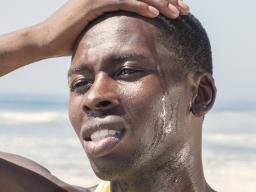- Advanced Practice Pulse
- Posts
- Beat It Heat! Part Deux
Beat It Heat! Part Deux
Back to School: Let's Protect Our Athletes and Review Heatstroke
Happy Tuesday! Hot topics this week continue to make us sweat! We have a malpractice impact report and leadership opposition to policy-makers. We share important knowledge to save lives in the heat and articles to keep students cool during interview season!

Credit: Giphy
In Today’s Edition:
Johns Hopkins study reveals impacts of malpractice
Nursing organization leadership opposition to policy-maker's mandates
Exertional Heat Stroke: The leading cause of preventable death in high school athletics
Save A Life: The signs and symptoms of heat exhaustion
Inspirational Interview worth the repost with Dr. Bernard Toney Jr.
Future APPs: It’s Interview Season, Preparation Tips to Keep Your Cool
Clinical Case Part 2: Treatment of Heat stroke: Don't Lose Your Cool!
🩺 APP Trending News
Johns Hopkins study reveals impacts of malpractice
An estimated 795,000 Americans die or suffer permanent disabilities annually due to incorrect medical diagnoses. The problem extends across various medical care settings and affects around 11% of cases. Strokes, sepsis, pneumonia, blood clots, and lung cancer account for almost 40% of misdiagnosis-related deaths and disabilities. Addressing diagnostic errors for these five diseases could prevent up to 150,000 fatalities each year. Pro-tip: More testing alone will not deliver diagnostic value; we must always consider the broad differential diagnosis. The Armstrong Institute Center for Diagnostic Excellence was born from the need to further the science of diagnostic safety and quality and misdiagnosis.
Nursing organization leadership opposition to policy-maker's mandates
The American Organization of Nursing Leadership (AONL) opposes government mandates on nurse-to-patient staffing ratios, stating that staffing decisions should be made collaboratively by organizational leaders, nurse managers, and direct care nurses based on patient needs and available resources. AONL argues that mandated ratios do not consider individual patient needs and remove nurses' real-time clinical judgment and flexibility.
⚙️ The More You Know
Let’s Protect Our Athletes!
Exertional Heat Stroke: The leading cause of preventable death in high school athletics
The National Federation of State High School Associations (NFHS) is an organization that provides leadership for high school sports and other activities. The NFHS Learning Center provides online courses for coaches, officials, administrators, and students. There are certifications available and this week, we are highlighting their Heat Illness Prevention course. Share this with your coaches, maybe save a life!
Save a life: The signs and symptoms of heat exhaustion
Heat exhaustion can occur when the body is dehydrated and unable to regulate its internal temperature, and if left untreated, it can lead to heatstroke, which is a potentially fatal condition. The quick read aims to educate people about the signs and symptoms of heat exhaustion and how to prevent it.
Hungry for more? Knowledge is Power
Anyone can learn more how to protect young athletes with this easy-to-follow course, Heat-Related Illness, by the CDC. Knowledge is the power to save a life. Share the course with your non-medical friends.
💡Inspiration for Aspirations
Worth a Re-post: Get some water, this interview will set your motivation on fire. 🔥
Meet our Inspiration for the Week: Bernard Toney Jr., DMSc, MPH, PA-C
Dr. Toney is a former US Combat Veteran & White House Medical Officer (Executive to the Office of the President & sole provider to the Vice President and First Lady), NIH Associate Investigator, Senior Advisor to the Master of Public Health Program at the University of Lynchburg, Leader, Educator, global health advocate, and so much more.

Dr. Bernard Toney Jr.
Q: Tell us about your background and what inspired you to become a PA?
A: From a very young age, life compelled me to walk a path I hadn’t initially envisioned. I was 17 when I experienced a moment that shook me to my core: a drive-by shooting that claimed my best friend’s life. This tragic event introduced me to a harsh reality that exists in our society, but it also instilled in me an intense desire to make a difference. In my quest for purpose amidst despair, I found myself serving alongside special forces medics in Afghanistan. These individuals, facing danger every day, held a singular dream—to join the Interservice Physician Assistant Program (IPAP) upon returning home. Their selfless dedication, their commitment to healing and saving lives, left a deep impression on me. Their dream gradually became my own, a seed planted in the tough soil of adversity.
This background of mine, shaped by tragedy and hope, is what inspired me to become a Physician Assistant. My journey has taught me the preciousness of life and the power of healing. I plan to carry these lessons forward as I continue my work, bringing compassion and care to those who need it most.
Q: What advice do you have for aspiring healthcare professionals who wish to positively impact their patients’ lives and the healthcare community as a whole?
A: Embrace a Holistic Approach:
To all aspiring healthcare professionals, you’re on an enriching and equally challenging journey. Here’s my advice on creating a meaningful impact in your patients’ lives and the broader healthcare community: Health isn’t just about the absence of disease; it is a state of physical, mental, and social well-being. Recognize that your patient is more than a set of symptoms.
Understand their life circumstances, their culture, their fears, and their hopes. It’s essential to comprehend the social determinants of health - socioeconomic status, education, physical environment, employment, and social support networks, among others. Your ability to integrate these aspects into your care will make you a more effective healthcare provider.
Becoming a healthcare professional who can make a real difference is a marathon, not a sprint.
Stay patient, stay passionate, and remember - every step you take brings us closer to a world where healthcare is a right, not a privilege.
Q: Is there anything else you would like to share with our readers?
A: My philosophy is simple” Lift as you Climb.” In that way, we all have a collective responsibility to support and elevate one another to reach our fullest potential.
This is so true. We are. in this together, as humans, as providers.
We highly recommend connecting with Dr. Toney on LinkedIn as he regularly posts thoughtful, motivational material. Thank you for your ongoing commitment to service, education, and inspiration! 🫡 🙌🏼
LinkedIn @ https://www.linkedin.com/in/btoneyjr/
Appointments: https://calendly.com/drbtoney
My philosophy is simple ‘Lift as you Climb.’ In that way, we all have a collective responsibility to support and elevate one another to reach our fullest potential.
📈Future APPs

Credit: Giphy
It’s Interview Season, Preparation Tips to Keep Your Cool
The PA school interview process is a tough one, so is the NP/CRNA/CNM process. Being prepared is key. As an interviewer (and survivor of grad school), I found these resources particularly helpful, in addition to the AAPA resources. The second link offers prep for other areas including dentistry, medical, nursing, veterinary, DNP and more!
Interested in a 1:1 consultation? Send me an email and we can set up a time to talk! [email protected]
Pro-tip: You cannot over prepare! 🎓
🧪Clinical Conundrums: Because We Love a Challenge!
Clinical Case Continued…Treatment of Heatstroke: Don't Lose Your Cool!
The patient met criteria for exertional hyperthermia. In terms of the differential, you should have picked “all of these.” Why? Consider her history of schizophrenia. Any of the ‘usual’ treatments for schizophrenia could include antipsychotics or SSRIs placing her at risk for NMS or serotonin syndrome. Sepsis, endocrinopathies, CNS infection, or toxic ingestions should always be considered. Given her history, and clearance with a non-focal exam (no clonus or rigidity) or non-focal evidence of infection, and negative tox screen, we can treat her for hyperthermia. (Note we would have done that while ruling out other etiologies).
With treatment including airway protection and heavy sedation to prevent shivering, our patient’s CK normalized and LFTs from shocked liver returned to normal and she recovered. Her antipsychotic regimen was carefully restarted prior to discharge.
The infographic below is a quick overview of the treatment and work-up for heat stroke. You can find more information including a podcast and book chapter covering the complete workup and treatment of hyperthermia and heat stroke here from EMCrit.org.

Credit: The Internet Book of Critical Care
**Disclaimer, this is a case-based exercise and not medical advice or a substitution for individualized care. By the time you read this, the current treatment may be outdated. Do your due diligence when seeking patient care resources.
🔎ICYMI
The US healthcare system is evolving and it's time we prepare for provider shortages
Speaking of provider shortages, Dr. Ogunfiditimi has a plan
Beat the Heat: Review heat-related illness, it could save a life!
Meet our Inspiration for the Week: Bernard Toney Jr., DMSc, MPH, PA-C, US Combat Veteran, White House Medical Officer, Global Health Advocate, Leader, Educator, and SO much more…
Considering an advanced certificate, degree, or other career in health? University of Lynchburg may have you covered
Patient Case Review: Don't lose your cool
You don’t want to be the only interesting APP at the water cooler. Please share with friends, subscribe, and let us know what you would like to see in upcoming editions! Aspire to add content contributions to your CV or your accomplishments? Please share your knowledge. We would love to hear from you!
Email [email protected]
:





